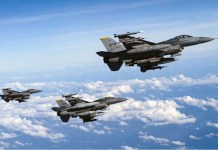Dunhuang in northwest China was a major stop on the ancient Silk Road, but U.S. military experts at first thought they were observing a different sort of mirage rising in the Gobi Desert about 100 kilometers to the west.
Analysis of satellite images taken in 2013, by Thomas Shugart, a U.S. Navy commander, and others led to the conclusion that what they were observing was a missile impact test site constructed by China.
But what caught Shugart’s attention was the layout in the sand of target ships. It was a mirror image of the layout of the U.S. Yokosuka Naval Base in Kanagawa Prefecture. In the middle of three targets designed as naval ships was what looked like a crater where a missile had impacted.
In a 2017 report published by Shugart and others titled, “First Strike: China’s Missile Threat to U.S. Bases in Asia,” another point made was that a different target at the test site bore a striking resemblance to the fighter jet tarmac at Kadena Air Base in Okinawa Prefecture.
The report said “a pre-emptive missile strike (by China) against the forward bases that underpin U.S. military power in the Western Pacific could be a real possibility.”
Andrew Krepinevich, the former president of the Center for Strategic and Budgetary Assessments, also remembers another satellite image he saw a few years ago in which a lineup of aircraft carriers was depicted in the desert.
“It called to mind the strike on Battleship Row at Pearl Harbor,” he said.
Because of his expertise, Krepinevich has a strong influence on policy toward Asia within the Pentagon. He has passed on his fears to high-ranking government officials and Self-Defense Force officers he has known for many years. He has told them our alliance should take steps to avoid being the victims of a surprise attack.
U.S. WITHDRAWAL FROM INF
On Feb. 1, the Trump administration notified Russia of its intention to withdraw from the Intermediate-Range Nuclear Forces Treaty, which was in many ways a symbol of the end of the Cold War. If the treaty is invalidated, both the United States and Russia will be able to deploy intermediate-range missiles.
Elbridge Colby, who served as deputy assistant secretary of defense for strategy and force development in the Trump administration until 2018, said, “the actual primary reason behind U.S. withdrawal was Russian violation, but the best reason is China.”
Because the INF Treaty does not cover China, it has built up the world’s largest arsenal of medium-range and intermediate-range missiles, such as the DF-21 and DF-26.
The United States has strengthened its missile shield by creating a ballistic missile defense system with Japan.
However, a high-ranking U.S. government official said China’s capabilities in terms of intermediate-range missiles had already exceeded that of the United States both in quantity and quality.
“It is no longer possible to defend against it only with the ‘shield,’ but we now also need a ‘spear,’ ” the official said.
Several U.S. media organizations have reported that once the INF Treaty becomes invalid, the Trump administration plans to deploy land-based intermediate-range cruise missiles in August and proceed with launch testing of intermediate-range ballistic missiles in November.
The United States is seeking to forward-deploy conventional intermediate-range missiles in the Asia-Pacific, and one Pentagon source said that among the candidate nations for such deployments are Japan and the Philippines.
If Washington does proceed with the deployment of such missiles, the Far East could become the stage for a missile war between the United States and China. That means what happens after the invalidation of the INF Treaty in four months’ time is also a vital issue for Japan.
CHINA UPGRADED ROCKET FORCE AS MILITARY BRANCH; BROADCAST MISSILE LAUNCH CAPABILITIES
In January, Chinese state-run TV for the first time broadcast the test launch of the DF-26, its latest intermediate-range ballistic missile that has been dubbed “Guam Killer.”
The footage showed 12 huge missile transport vehicles moving into position while kicking up a cloud of dust. After the missiles were raised into a vertical position, the video switched to seven personnel crouching behind sandbags and showed them responding to orders to fire by pressing red buttons to launch the missiles.
According to Chinese newspapers, the DF-26 has four wings on its tip that allows it to modify its course. It is so advanced the missile can also hit moving targets, such as aircraft carriers.
Du Wenlong, a professor at China’s Academy of Military Sciences, said on a TV program, “There is no comparable intermediate-range ballistic missile internationally. It has a capability that cannot be copied by any other nation.”
At the end of 2015, the Chinese military upgraded its 2nd Artillery Corps to the same level as one of the three other military branches and established a “rocket force.”
Chinese President Xi Jinping attended the ceremony to mark the occasion and said, “The rocket force is the core military component for China’s strategic deterrence and is the cornerstone of the state’s national security. You must heighten the precision attack capability of intermediate and long-range missiles.”
Beijing has been especially keen about developing and deploying medium-range and intermediate-range missiles capable of hitting targets between 1,000 and 5,500 km away. Over the past decade or so, it has not only increased the types of missiles and their numbers, but also the range and accuracy.
Regarding the preference for intermediate-range missiles, rather than intercontinental ballistic missiles that could reach the U.S. mainland, a researcher at a Chinese government-affiliated think tank, said, “We have no intention of waging an all-out war with the United States. Our main priority is to prevent the U.S. military from approaching China in a military contingency and intermediate-range missiles are very important for that purpose.”
That strategy of China’s has been called “anti-access, area denial” (A2/AD) and it was heavily influenced by what Chinese officials witnessed and learned in the 1990s during the Persian Gulf War and the crisis over the Taiwan Strait.
According to a high-ranking Chinese military officer, what was then the General Staff Headquarters of the People’s Liberation Army and other entities conducted an analysis of why Iraq lost the Persian Gulf War in 1991. One conclusion was that Iraq might have minimized the damage caused by bombing attacks if it had launched a first strike against the bombers of the multinational alliance that had gathered in neighboring Saudi Arabia.
During the Taiwan Strait crisis, the U.S. Navy deployed two aircraft carrier strike groups to the area. Chinese officials felt a deep sense of crisis over how closely those aircraft carriers had approached their homeland and painfully realized they did not possess the means to hold off the enemy’s bases in those allied nations.
Internal documents that the Chinese military compiled in 2004 for the 2nd Artillery Corps pointed out, “If our troops invaded Taiwan, the enemy would likely intervene by using the aircraft carriers and bases of allies located in our vicinity. Conventional missiles would be effective as a warning shot against the enemy.”
It is unclear how seriously China is preparing for a first-strike attack on U.S. bases, but the document also said deterrence might be heightened by showing the enemy what China was capable of by allowing other nations to take satellite images of its missile exercises.
China has been pushing forward with its strategy while perfectly aware that both the United States and Russia were hampered by the INF Treaty from deploying land-based intermediate-range missiles. China now has an overwhelming advantage over the United States in such missiles.
Moreover, it has also begun developing hypersonic missiles that can be separated from ballistic missiles while in flight and guided while traveling at speeds of Mach 5. That would make predicting where the missile was heading all but impossible.
Randall Schriver, assistant secretary of defense for Indo-Pacific security affairs, said that China was one of the nations that had the latest technology for hypersonic weapons.
U.S. SEEKING MISSILE DEPLOYMENT IN JAPAN
In February, shortly after the Trump administration formally announced its intention to withdraw from the INF Treaty, the United States-China Economic and Security Review Commission issued a report about how that decision would impact security matters in the Asia-Pacific. It made reference to the possibility of deploying missiles to Japan and said, “U.S. missiles could also potentially be mobile, hidden, and dispersed throughout the territories of its allies and partners—for example in the Ryukyu Island chain in Japan’s southwest or in the jungles of the Philippines—all of which would complicate Chinese military planning.”
The U.S. military believes that even conventional missiles capable of reaching China would serve as a major deterrent. The question is where to place those missiles.
The political risk of deploying such missiles in Taiwan would be extremely high given that Beijing considers the island part of China.
While several U.S. government sources admitted the Philippines was also one of those nations being considered, the stance of the current Philippine government toward the United States lacks stability.
A former high-ranking official at the U.S. State Department said, “The Trump administration believes Guam is too far away and that Japan is the most suitable geographically.”
A Pentagon source said there were several candidate sites besides Okinawa.
While the government has not yet received a formal request for deployment, a high-ranking Defense Ministry official said, “If we are approached, we would face a very difficult choice.”
Many elements of the INF Treaty, including how it was agreed to, are closely intertwined with Japan’s national security.
In February 1986, Prime Minister Yasuhiro Nakasone and U.S. President Ronald Reagan exchanged a number of letters on what should be included in the treaty.
A preliminary draft had all intermediate-range missiles removed from Europe, but Russia would be allowed to maintain half of its missiles in Asia. Japan asked for a change on the grounds that there should be a balance in deployment between Asia and Europe. Japan played a major role in ensuring that all such missiles were also removed from Asia.
In October, when President Donald Trump indicated that the United States would withdraw from the treaty, Prime Minister Shinzo Abe said, “We place importance on the historic role the treaty has played. It is not desirable to create a circumstance in which that treaty will have to be ended.”
His comments touch upon the Japanese connection to the treaty.
But when the U.S. government formally announced it was withdrawing in February, all Chief Cabinet Secretary Yoshihide Suga said was, “We understand (the U.S.) position on this issue.”
The government switched to a position of supporting Washington, based largely on its concerns about China.
But the question remains of what the government will do without the INF Treaty.
In March, the National Security Secretariat exchanged views on this issue with a number of experts.
According to a source, one participant said, “The government should actively consider various options, including allowing for the deployment of intermediate-range missiles in Japan.”
There are some government officials who feel that with Japan well within the range of Chinese missiles, forward deployment of U.S. missiles would serve as a deterrent.
However, one high-ranking Foreign Ministry official said, “If the missiles are deployed in Japan, not only would U.S. bases in Japan become Chinese targets, but it could trigger an arms race between the United States and China.”
Views are also divided in the United States.
Franklin Miller, who served as a special assistant to President George W. Bush, said a “huge political problem” would be created for Japan if the United States proposed deploying the missiles there.
“It would create divisions in Japanese society,” Miller said between those pro- and anti-United States.
But Colby, who served as deputy assistant secretary of defense in the Trump administration, said, “The situation in Asia is not static. And the military balance is dramatically deteriorating. That is going to have change the political discussion in places like Japan.”
IS NEW ARMS CONTROL FRAMEWORK POSSIBLE POST-INF TREATY?
When the United States announced it was withdrawing, Trump also said he thought a new multilateral framework that would include China should be considered.
Foreign Minister Taro Kono jumped in and offered support to that idea, saying at a Feb. 5 news conference, “China already possesses a similar type of missile. Multilateralizing the INF Treaty is a necessity for global disarmament. Japan will work aggressively toward that goal.”
But China wanted no part of that new proposal.
Wu Qian, a spokesperson for the National Defense Ministry, said at a March 28 news conference, “The INF Treaty is between the United States and Russia. China opposes the unilateral invalidation by the United States and the multilateralization of the treaty.”
According to several Western think tanks, while the United States and Russia both have about 6,000 nuclear warheads, China has less than 300.
Han Kedi, an associate research fellow at the Institute of Russian, Eastern European and Central Asian Studies at the Chinese Academy of Social Sciences, said that China was not yet at a stage to discuss disarmament on an equal standing with the United States and Russia.
Some in the U.S. government insist that China will only be forced to the negotiating table when it faces the forward deployment of new intermediate-range missiles. But such an approach could also trigger an arms race.
George Shultz, who served as U.S. secretary of state from 1982 to 1989, said withdrawing from the INF Treaty was a huge step backward because now was not the time for increasing the number of nuclear weapons, but a time for removing the threat from such weapons.
Kashmiri Pandit Urges KP Community To Re-Unify with Muslims for Mother Kashmir: Opinion
A high-ranking Foreign Ministry official was pessimistic about the prospects of reaching an agreement on an arms control framework that included a large number of nations to serve as a replacement for the INF Treaty.
Hirofumi Tosaki, senior fellow of the Center for the Promotion of Disarmament and Non-Proliferation at the Japan Institute of International Affairs, said, “It is difficult to foresee the creation in Asia of an arms control framework that would place numerical limits or reductions on missiles.”
He added that strategic discussions were needed between Japan, the United States and China to consider what risks might exist in Northeast Asia should the situation arise of the United States deploying missiles there after the treaty was invalidated.
More News at EurAsian Times
- Indian Military Base in Sabang can Strangle China at the Strait of Malacca
- Why is Japan Unhappy with Bullet Train Project in India?
- Is Saudi-UAE Alliance Working to Weaken the Gulf Cooperation Council?
- India-Japan Defence Partnership Aggressively Countering China
- Oman-UAE Relations Deteriorate; Muscat Warns Against Testing Patience




